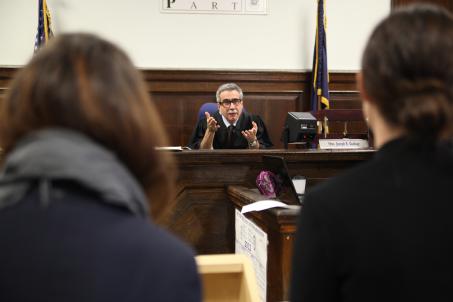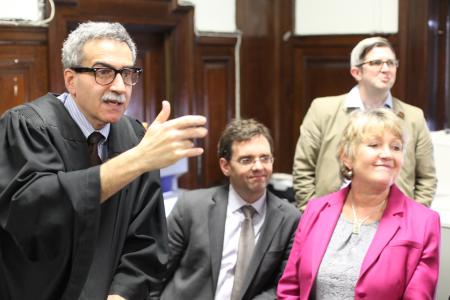Judge Joseph Gubbay, who presides over one of nine pilot sites of the Adolescent Diversion Program, explains how the initiative is expanding the
justice system’s options for dealing with 16- and 17-year-old defendants, who are currently treated under New
York law as adults, even for non-violent offenses.

the Adolescent Diversion Program.
ROB WOLF: Welcome to New Thinking. I’m Rob Wolf, Director of Communication at the Center for Court
Innovation. Today’s podcasts focuses on a special pilot program called the Adolescent Diversion Program. I’m
in the chambers of Supreme Court Justice Joseph Gubbay, who presides over one of nine sites across New York State
where the adolescent diversion program is being carried out. Glad you could join me on New Thinking today.
JOSEPH GUBBAY: Thank you very much. It’s wonderful
to be here.
ROB WOLF: I think
it would be helpful to start with an overview of what the adolescent diversion program is. So what is it and how
did it come about?
JOSEPH GUBBAY:
Let me give you a little background. New York State and North Carolina are the only two states which prosecute 16-
and 17-year-olds as adults. So Jonathan Lippman, the Chief Judge of the New York court of appeals identified this
inequity and recognized that in order to change it, there would have to be legislative change, which is slow going.
So to address the problem on a more immediate basis, he created these nine pilot programs. What are we trying to
accomplish? Three things. Number one, identify services which, if completed by the individual, will stop the behavior
that brought the individual to court in the first place.
ROB WOLF: And just to be clear, what kinds of charges are you handling in this court?
JOSEPH GUBBAY: We’re seeing actually a whole range
of charges. Certainly we’re seeing theft of services cases, which may involve jumping a turnstile, going into
the subway system without paying the lawful fare. We may see trespass, being in a location without permission or
authority, whether that’s a part after hours, whether that’s a housing development on somebody’s roof
or something like that. But we’re also trying to address the more complex cases, so this may involve assaultive
behavior within a family, assaultive behavior at a school. Goal number two, this is about growth and this is about
maturity, and this is about accountability. For this very, very young population, these are qualities that come with
experience, and these are qualities that come frankly with age. And what we’re trying to do is give this young
population, give these young people the tools to make better decisions, to become more responsible, and three, if
the services are performed as set forth by the court, they will end up without a criminal conviction. These three
goals are shared by myself, the chief judge, and this is the underlying policy of the court. Now none of this could
happen unless you have a progressive prosecutor. And we are very fortunate to have Charles Hynes as the district
attorney of Kings County, who recognizes that this young population really needs to be treated a little differently.
And the services and change and growth are ultimately going to be safer for our community, and a better alternative
than jail. And I think it’s critical to recognize the incredible support that we’re getting from the defense
bar as well. Brooklyn Defender Services, the Legal Aid Society, and the private bar have devoted extraordinary resources
to ensure the success of this program.
ROB
WOLF: In the past, those crimes, those offenses that you’ve described, those all would have been handled in
a more conventional criminal court fashion, as a criminal offense?
JOSEPH GUBBAY: Absolutely. In a typical court, the case may be disposed of with a day or two of
community service cleaning up a park, but we’re trying to something much more than that. We’re trying to
provide a more nuanced approach so a lot of effort goes on in terms of an assessment to identify those specific and
particular needs of the individual that appears before us. That just cannot take place in a large all purpose traditional
court, where the volume of cases is crushing.
ROB WOLF: And I know you work closely with the Redhook Community Justice Center, which has an onsite
clinic and had extensive knowledge of community providers, social service providers, and relationships with them.
How, in fact, have they supported the work of the adolescent diversion program?
JOSEPH GUBBAY: It’s actually a two part model. My job is to identify
services and craft an offer and negotiate between the parties, between the prosecutor and the defense to make a deal
that’s going to work. Compliance is monitored by my colleague, Alex Calabrese.
ROB WOLF: So in essence, the young person comes here, appears before you,
their attorney, the prosecutor, yourself work out the plea, and then they’ll go a couple miles away to the Redhook
Community Justice Center where they might actually have onsite services, they appear before Judge Calabrese, who
monitors compliance, offers his words of encouragement, and they don’t come back here until the case is closed?
Or they never come back unless there’s a problem and they need a little shot in the arm to encourage them?
JOSEPH GUBBAY: Exactly, it’s the latter. Hopefully
then never come back to see me again. If they’re coming back to see me again, it’s because there’s
a problem.
ROB WOLF: I had a
wonderful chance to observe you in the court and I found you were very clear, you didn’t use jargon or lingo,
you seemed to really almost want it to be participatory. You asked people to raise their hand, was this their first
time here, were their family members here? Please raise your hand. You spoke directly to the defendants; you spoke
with their family members when they appeared before you did things like encourage the young person to thank their
guardian, who presumably took time off of work, made an effort to be with them. So there was a certain accessibility
there, and I also thought an attempt to really make sure that the young person understood and wasn’t just a
cog. And I wonder, is this how you always are, or is this a reflection of the fact that a young person, as you’ve
said, that they are in fact different than adults.
JOSEPH GUBBAY: I come to the adolescent diversion part having served in a felony drug treatment
court for many, many years. So I have experience in the area of recovery, in the area of providing services, and
in the area of—I want to call it—engagement. Because there are two models at work here. There’s the coercive
element. If you don’t do it, there’s gonna be a punishment. You have to do it, okay. That doesn’t
always work. There has to be engagement. There has to be internal motivation. So what I’m trying to do is, I’m
trying to communicate and get across that this is going to be something that is going to be good for you and your
family, and those you care about the most. I think it is very, very important, whether in adolescent diversion part,
or whether you’re in a conventional, traditional part, that the process is transparent. And in order for it
to be transparent, then it needs to be intelligible, it needs to be understandable, and it needs to be in a language
that’s gonna be accessible.
ROB
WOLF: So what is it like working with young people, versus your experience working, even with adults in drug court?
And what’s your feeling as the pilot moves forward? You know, has it been successful and what have you learned?
JOSEPH GUBBAY: you know, I’m very, very encouraged.
Our rough sense is that we have a very high compliance rate, somewhere around 80, 85 percent which is extraordinary.
And there needs to be some flexibility, there needs to be second chances, there may even need to be third chances.
ROB WOLF: There are nine pilots that are being carried out in different counties, including here in Kings
County, which is otherwise known as Brooklyn, with the ultimate goal, perhaps, of legislative change so that it’ll
become system wide. And I wonder how you feel about the advantages about testing it in these pilot sites before it
goes system-wide.
JOSEPH GUBBAY: The creation of a pilot program before this goes live if you
will, very sound, very prudent. And it’s exciting to be in the middle of it.
ROB WOLF: Well
it’s been exciting talking to you today. I’m Rob Wolf, Director of Communication at the Center for Court
Innovation and I’ve been speaking with Kings County Supreme Court Justice, Joseph Gubbay, who presides over
the Adolescent Diversion Program here in Brooklyn.
JOSEPH GUBBAY: Rob, thanks for having me.
ROB WOLF: To find out more about the adolescent diversion program or hear more of our podcasts, you can
visit our website at www.courtinnovation.org, or you can listen to us through iTunes. Thanks very much for listening.
Podcast: Play in new window | Download
